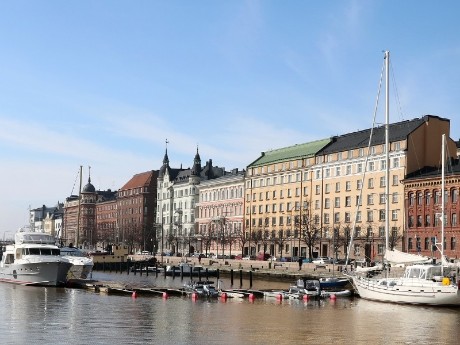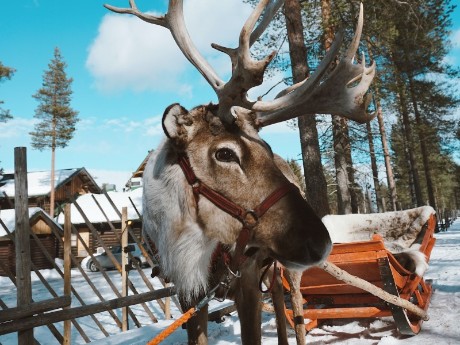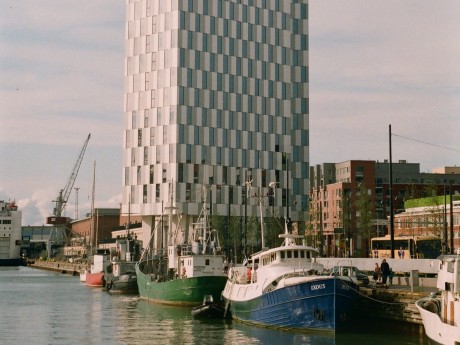Finland: Helsinki and Rovaniemi
Come explore Finland's unique blend of culture, nature, and enchantment. Your trip begins in the capital of Finland, Helsinki, with a visit to the iconic Helsinki Cathedral and a leisurely walk through the beautiful Esplanadi Park. Explore the vibrant Market Square, where you can savor local treats or take ferry to Suomenlinna Fortress to learn its history. End your trip by flying to Rovaniemi, the capital of Lapland.
Read more
Come explore Finland's unique blend of culture, nature, and enchantment. Your trip begins in the capital of Finland, Helsinki, with a visit to the iconic Helsinki Cathedral and a leisurely walk through the beautiful Esplanadi Park. Explore the vibrant Market Square, where you can savor local treats or take ferry to Suomenlinna Fortress to learn its history. End your trip by flying to Rovaniemi, the capital of Lapland. Start with a visit to the Arktikum Science Centre and Museum, offering insights into the Arctic region. Explore the Santa Claus Village, meet Santa himself, and send greetings from the Arctic Circle. End your trip with a chance to witness the mesmerizing Northern Lights. From Helsinki's cultural vibrancy to Rovaniemi's Arctic wonders, you will encounter the very best of Finland's culture and beauty. Waterviews strives to offer accommodation options within walking distance of water and/or in an area of touristic interest. Our prices include taxes (but excludes local tourist taxes). Customize your trip to your personal preferences with optional activities (hit the “Add Activities’’) or change hotels, etc. Contact us for customization at no extra cost at: Service@waterviewstravel.com
Destinations
- Helsinki
- Rovaniemi
Itinerary
Helsinki

As the country's capital as well as its cultural heart, the vibrant city of Helsinki is a must on any Finnish itinerary. From the magnificent blend of historic and contemporary architecture to the countless museums, galleries and exhibitions, visitors will be delighted with what this city has to offer. Be sure to stop at the unique Temppeliaukion Church and the majestic cathedral, and spend days strolling through the city centre where you can shop in boutique design stores, sample local cuisine in world-class eateries and relax in cosy cafes.
Read more
As the country's capital as well as its cultural heart, the vibrant city of Helsinki is a must on any Finnish itinerary. From the magnificent blend of historic and contemporary architecture to the countless museums, galleries and exhibitions, visitors will be delighted with what this city has to offer. Be sure to stop at the unique Temppeliaukion Church and the majestic cathedral, and spend days strolling through the city centre where you can shop in boutique design stores, sample local cuisine in world-class eateries and relax in cosy cafes.
Additional Information
History
As Finland became part of the Swedish kingdom in the 13th century with Turku as its regional capital, Helsinki was founded in AD 1550 by King Gustav Vasa of Sweden as a trading post to compete with Tallinn to the south in Estonia, which was Danish at that time. Helsinki was established about 5 km northeast of the current downtown, at the rapids where Vantaa river (at that time known as Helsinge river) flows into the Baltic Sea, which in turn gave the city its Swedish name Helsingfors. Never becoming the trading post Gustav Vasa envisioned and largely bypassed by the King's Road — the major road along the coast at that time — the village faced some hard times during its first centuries with fires and diseases and today there is but a few stones left of the original Helsinki. Eventually the city was moved further south to its current location and in the middle of 18th century Sveaborg (nowadays Suomenlinna in Finnish) Maritime Fortress was established in the front of Helsinki. The now world heritage-listed fortress archipelago features some of the oldest standing buildings in the city.
In 1809, Finland was annexed by Russia after the Finnish War (a part of the Napoleonic Wars), and the capital of Finland moved from Turku to Helsinki in 1812.The Czar felt the Grand Duchy of Finland needed a capital of grand proportions, and this was a major turning point in the history of Helsinki. The architects Johan Albrecht Ehrenström, a native Finn, and Carl Ludwig Engel, from Germany, were given the task of rebuilding the city in the Empire style. This can be seen today around the Lutheran Cathedral, which was completed in 1852. The same style, and even architects, is also a part of Saint Petersburg's history.
Growing steadily during the 19th century, with the population exceeding 100,000 by the turn of the century, Helsinki had established itself as the largest city and ad the political and cultural capital of the country. The city was a battleground in the Finnish Civil War 1917-18, and was bombed by the Soviets in the Second World War. Before the war Finland was largely an agricultural country but the industrialization and urbanization that happened during the following decades meant an influx of new inhabitants from the rural parts of the country and turned Helsinki into the metropolis it is today with suburbs, superhighways and even a small subway system. Architectonically a young city, many of the monumental buildings erected since the independence have a stark modernist style and the rest of the city's architecture is made up of National Romantic style buildings from the early 20th century and the aforementioned Empire style buildings in Central Helsinki. Though thoroughly a Nordic capital, Helsinki today reflects the influences gained from the Western and Eastern cultures.
Tourist information
There is also another one right in the Central Railway Station.
Climate
Helsinki is among the world's northernmost capitals and the lengthy winter is dark and chilly. Winter temperatures average , but the wind chill and humidity makes it feel even colder and the mercury can plunge below on a particularly cold day. Days are short. In general snow falls only intermittently and often melts into grey slush. However lake-effect snowfalls dropping copious amounts of snow during a few hours (and messing up the traffic) is not unheard of in the early winter. Since the Helsinki peninsula juts into the sea, there is often a cold sea wind, and the climate is more maritime than inland, with snow and replaced by slush, sleet and . This is especially apparent in November and December, but the first months of the year almost always have colder temperatures and clear skies.
The spring brings clear skies but the temperature doesn't increase as fast as the sunshine hours; even in April you may experience sub-zero nights, even as the afternoon temperatures raise above . The summer is often pleasant. Daytime temperatures are usually around and July and August afternoons often see temperatures above 25 °C, and unlike the rest of the year you don't need a jacket or sweater even at nighttime. The sun sets late in the night and even then dusk turns into dawn without any real darkness in between. Parks burst into green, sunbathers dot the city's beaches and restaurants and bars deploy their terraces and patios, making the streetscape look more Central European for a couple of months. The autumn slowly developes throughout September with fall foliage and moderate temperatures; snow and seriously cold weather before early November is very uncommon.
Talk
The city is officially bilingual, with an 86% Finnish-speaking majority and a visible 6% Swedish-speaking minority. Many in the Finnish-speaking majority only know the basics of Swedish, which they learned in school, while some speak it fluently.
The majority of Finnish-speaking people are much more comfortable with speaking English than Swedish, and especially the younger generations usually speak very good English. Although locals will appreciate an effort to say a few words in Finnish, they know very well how difficult Finnish is and will readily switch to English – many people also like the chance to practice their English.
Finnish letters are always pronounced the same way, regardless of context (unlike e.g. English "a" in "car" and "hat"), with letters doubled for long sounds. Word stress is always on the first syllable. This makes it easy to learn how words should be pronounced, while actually pronouncing them correctly may be quite difficult.
Street signs and most other signs are usually in both Finnish and Swedish. In tourist-oriented areas, English signage is also prevalent. The Finnish and Swedish names for different streets and areas in Helsinki may differ significantly, for example Suomenlinna/Sveaborg for the fortress or Pasila/Böle for one of the train stations.
Being Finland's most cosmopolitan area by a fair margin, Helsinki also houses people from different parts of the world. While strolling around, you may hear people converse in Estonian (which at first sounds a lot like Finnish), Russian, German, and Somali.
© Sourced from Wikivoyage
Rovaniemi

The capital of Finnish Lapland, Rovaniemi is the perfect destination to experience the region’s enchanting natural wonders. Known as the ‘official’ residence of Santa Claus, families will delight at the town’s Santa Claus Village that offers a number of exciting attractions year-round. There are also some excellent museums here, and Rovaniemi is home to Finland's northernmost zoo. In the surroundings you'll find plenty of opportunities for both summer and winter activities, and you may even have the chance to spot the northern lights.
Read more
The capital of Finnish Lapland, Rovaniemi is the perfect destination to experience the region’s enchanting natural wonders. Known as the ‘official’ residence of Santa Claus, families will delight at the town’s Santa Claus Village that offers a number of exciting attractions year-round. There are also some excellent museums here, and Rovaniemi is home to Finland's northernmost zoo. In the surroundings you'll find plenty of opportunities for both summer and winter activities, and you may even have the chance to spot the northern lights.
Additional Information
Rovaniemi, the business centre of Finnish Lapland since the 19th century, was razed to the ground by the Germans in the final days of World War II with only a handful of buildings left standing. Rebuilding after the war and economic development over the ensuing decades have left much of the city a featureless expanse of concrete blocks, regardless of Alvar Aalto's famous reindeer antler city plan (try to recognize it if arriving by plane). Rovaniemi became a city in 1960, and in 2006 it merged with the surrounding rural municipality.
Most tourists come because of Rovaniemi's central position for transportation, because of its location at the Arctic Circle or to see Father Christmas, but there are several sights worth a visit.
Because of its central location and status, Rovaniemi has become a center of education in Finnish Lapland. There are as many as 10 000 university and university of applied sciences level students living in Rovaniemi. Compared to the number of inhabitants living in the old city area (pre-2006), as many as one in three or four people are students. During summers this shows as a large drop in the number of people vacating the city.
The river Kemijoki, notable for being the longest river in Finland, runs next to the city center. On the west side of the river there is a large hill called Ounasvaara.
© Sourced from Wikivoyage





